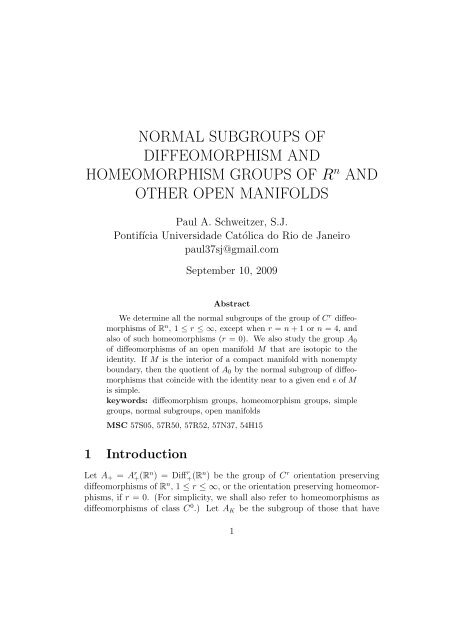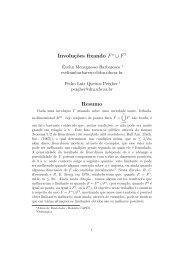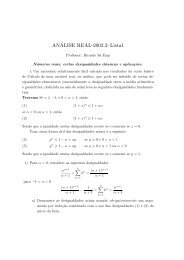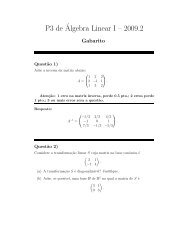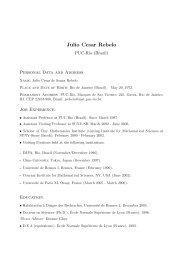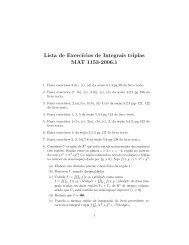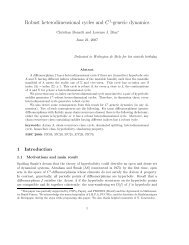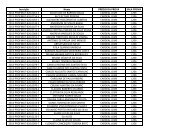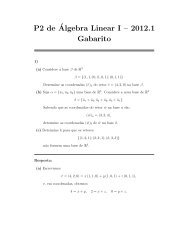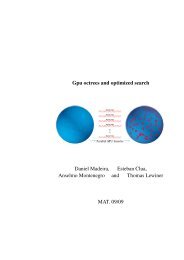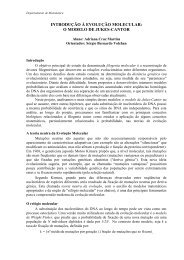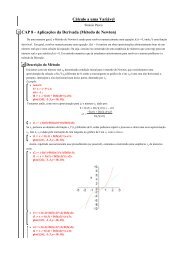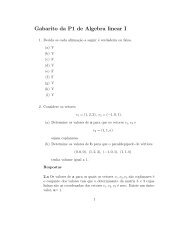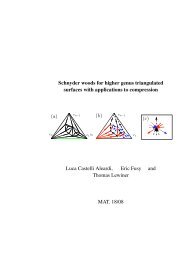NORMAL SUBGROUPS OF DIFFEOMORPHISM AND ...
NORMAL SUBGROUPS OF DIFFEOMORPHISM AND ...
NORMAL SUBGROUPS OF DIFFEOMORPHISM AND ...
Create successful ePaper yourself
Turn your PDF publications into a flip-book with our unique Google optimized e-Paper software.
<strong>NORMAL</strong> <strong>SUBGROUPS</strong> <strong>OF</strong><br />
<strong>DIFFEOMORPHISM</strong> <strong>AND</strong><br />
HOMEOMORPHISM GROUPS <strong>OF</strong> R n <strong>AND</strong><br />
OTHER OPEN MANIFOLDS<br />
Paul A. Schweitzer, S.J.<br />
Pontifícia Universidade Católica do Rio de Janeiro<br />
paul37sj@gmail.com<br />
September 10, 2009<br />
Abstract<br />
We determine all the normal subgroups of the group of C r diffeomorphisms<br />
of R n , 1 ≤ r ≤ ∞, except when r = n + 1 or n = 4, and<br />
also of such homeomorphisms (r = 0). We also study the group A 0<br />
of diffeomorphisms of an open manifold M that are isotopic to the<br />
identity. If M is the interior of a compact manifold with nonempty<br />
boundary, then the quotient of A 0 by the normal subgroup of diffeomorphisms<br />
that coincide with the identity near to a given end e of M<br />
is simple.<br />
keywords: diffeomorphism groups, homeomorphism groups, simple<br />
groups, normal subgroups, open manifolds<br />
MSC 57S05, 57R50, 57R52, 57N37, 54H15<br />
1 Introduction<br />
Let A + = A r +(R n ) = Diff r +(R n ) be the group of C r orientation preserving<br />
diffeomorphisms of R n , 1 ≤ r ≤ ∞, or the orientation preserving homeomorphisms,<br />
if r = 0. (For simplicity, we shall also refer to homeomorphisms as<br />
diffeomorphisms of class C 0 .) Let A K be the subgroup of those that have<br />
1
compact support, and let A I be the subgroup of those that are isotopic to<br />
the identity by a compactly supported isotopy. Let κ : A K → π 0 Diff r +(S n ) be<br />
the homomorphism that takes a diffeomorphism f ∈ A K to the isotopy class<br />
of its extension to S n = R n ∪ {∞}. In particular, A I ⊆ Ker(κ). The group<br />
π 0 Diff r +(S n ) is easily seen to be abelian (by taking representative diffeomorphisms<br />
supported on disjoint balls), and if n ≠ 4 and r ≥ 1 it is known that it<br />
is isomorphic to θ n+1 , the finite abelian Kervaire-Milnor group of orientation<br />
preserving diffeomorphisms of S n up to h-cobordism [?]. Our main theorem<br />
is the following (with a stronger version in Theorem ?? below).<br />
Theorem 1.1 The groups κ −1 (η), where η varies over all the subgroups of<br />
π 0 Diff r +(S n ), are normal subgroups of A r +(R n ) if r ≥ 1. If r ≠ n + 1, they are<br />
the only proper normal subgroups. For homeomorphisms (r = 0), A I = A K<br />
is the only proper normal subgroup.<br />
In the 1960’s and early 1970’s, algebraic properties of homeomorphism<br />
and diffeomorphism groups were studied extensively in work of Anderson<br />
[?], Epstein [?], Herman [?], Thurston [?], and Mather [?, ?], among others.<br />
The fundamental result is Mather’s theorem [?, ?] that the group of C r<br />
diffeomorphisms of a smooth manifold M isotopic to the identity by isotopies<br />
with compact support is a simple group, provided that r ≠ dim(M) + 1.<br />
This theorem had been proven by Thurston [?] when r = ∞. (The case<br />
when r = 0 is fairly easy, and the case when r = dim(M) + 1 remains open.)<br />
These results are based on Epstein’s theorem [?] that under certain very<br />
general hypotheses, the commutator subgroup of a group of homeomorphisms<br />
is simple.<br />
In my lecture at the AMS Symposium on Pure Mathematics at Stanford<br />
University in August 1976, I presented theorems about groups of diffeomorphisms<br />
of R n . After the lecture, Wensor Ling, a graduate student working<br />
on his doctorate under Thurston at MIT and Princeton, mentioned that he<br />
had obtained similar results in his doctoral research. I decided to leave the<br />
publication of the results to the future Dr. Ling. Two years later, Dusa<br />
McDuff published a study [?] of the lattice of normal subgroups of the group<br />
of diffeomorphisms of an open manifold P that is the interior of a compact<br />
manifold with nonempty boundary. She referred to Ling’s preprint [?] and<br />
unpublished work of mine for the proof of a fundamental lemma stating that<br />
A 0 (P )/G i (in her notation, see [?] p. 353) is a simple group. Since the proof<br />
of this result and [?] have apparently never been published, I include its proof<br />
2
here as Theorem ??. I also prove some new results for any open manifold M.<br />
All the results are valid for diffeomorphism groups of class C r , r = 1, 2, . . . , ∞<br />
and also for homeomorphism groups (r = 0), except that r ≠ dim(M) + 1 in<br />
Theorem ?? since we use Mather’s theorem. I would like to thank Tomasz<br />
Rybicki for encouraging me to publish this paper after all these years.<br />
2 Definitions and Results<br />
We recall some definitions from McDuff’s paper [?]. Let M be a connected<br />
n-manifold. For r = 1, 2, . . . , ∞, we set A = A(M) = Diff r (M), the group<br />
of all C r diffeomorphisms of M with the C r compact-open topology, and for<br />
r = 0 we let A = Homeo(M) be the group of homeomorphisms of M. Let A 0<br />
be the identity component of A, so that it consists of the diffeomorphisms<br />
that are C r isotopic to the identity map I (or the homeomorphisms that are<br />
topologically isotopic to I, if r = 0). The support supp(g) of a diffeomorphism<br />
g ∈ A is the closure of the set {x ∈ M | g(x) ≠ x} and the support of an<br />
isotopy {g t | t ∈ [0, 1]} with g 0 = I is the closure of the union of the supports<br />
∪ t∈[0,1] supp(g t ). All manifolds are connected.<br />
Theorem 2.1 Let h ∈ A 0 be a diffeomorphism isotopic to the identity map<br />
of an open (i.e., non-compact) manifold M such that supp(h) is not compact,<br />
and let H be any normal subgroup of A 0 containing h. Then the subgroup A I<br />
of A 0 consisting of all diffeomorphisms that are isotopic to the identity map<br />
of M by isotopies with compact support is contained in H.<br />
In the case that the manifold M is R n , we have the following stronger<br />
version of Theorem ??, using the same notation.<br />
Theorem 2.2 Let A = Diff r (R n ) be the group of all C r diffeomorphisms of<br />
R n , 0 ≤ r ≤ ∞. Then the subgroup of orientation preserving diffeomorphisms<br />
A + , which coincides with the subgroup A 0 of diffeomorphisms isotopic to I,<br />
and the groups κ −1 (η) where r ≥ 1 and η varies over all the subgroups of<br />
π 0 Diff r +(S n ) (or, equivalently, of θ n+1 , if n ≠ 4) are normal subgroups of A +<br />
and (except possibly if n = 4) also of A. If r ≠ n + 1, these are the only<br />
non-trivial normal subgroups of A 0 = A + and of A. For r = 0, the only<br />
proper normal subgroups of A 0 and A are A K = A I and A 0 .<br />
3
The following result, used by McDuff [?] to study the lattice of normal<br />
subgroups of the group of diffeomorphisms isotopic to the identity on the<br />
interior P of a compact manifold ¯P with non-empty boundary, is fundamental,<br />
and will be proven in Section ??. Say that an end e of an open<br />
manifold M is a product end if it has a basis of neighborhoods homeomorphic<br />
to N × (0, 1/n] for some fixed closed (n − 1)-manifold N. Let A e be<br />
the subgroup of A 0 consisting of diffeomorphisms that are the identity in a<br />
neighborhood of e.<br />
Theorem 2.3 If e is a product end of M then A 0 /A e is a simple group.<br />
In the notation of [?], this says that if e is an end of P = Int( ¯P ) and<br />
G i = A e , then the group A 0 /G i is simple.<br />
The four following propositions and their corollaries are steps in the proofs<br />
of the theorems. Every ball considered in an n-manifold M will be a closed<br />
collared n-ball, i.e., the image of the closed unit ball in R n under a C r embedding<br />
of R n in M. Let B m , m = 1, 2, . . . , be a sequence of disjoint balls in an<br />
open manifold M that converge to an end e of M, i.e., every neighborhood<br />
of e contains all but a finite number of the balls B m .<br />
Proposition 2.4 Every diffeomorphism of M supported in ∪ ∞ m=1B m is isotopic<br />
to the identity map I.<br />
In particular, every diffeomorphism of an open manifold supported on a<br />
finite set of disjoint balls belongs to A 0 .<br />
Proposition 2.5 Let h ∈ A 0 be a diffeomorphism of M whose support meets<br />
every neighborhood of the end e and let H be a normal subgroup of A 0 containing<br />
h. If dim(M) ≥ 2, then there exists f ∈ H such that f(B m ) = B m+1<br />
for every m. Furthermore, every diffeomorphism of M supported in ∪ ∞ m=1B m<br />
belongs to H.<br />
In case dim(M) = 1 (so that M ≈ R), the same conclusions hold, provided<br />
that the disjoint intervals B m are in a monotone increasing (or decreasing)<br />
order on the line.<br />
Proposition 2.6 Let e be a product end of an open manifold M, and let H be<br />
a normal subgroup of A 0 = A 0 (M) containing a diffeomorphism h ∈ A 0 whose<br />
support supp(h) meets every neighborhood of e. Then there exist f ∈ H and<br />
a closed product neighborhood N 0 of e such that the sets f m (N 0 ) for m ≥ 0<br />
are nested (f m+1 (N 0 ) ⊂ Int f m (N 0 )) and form a neighborhood base for e.<br />
4
Note that the diffeomorphism f is related to the translations of [?].<br />
Corollary 2.7 Under the same hypotheses on h and H, every diffeomorphism<br />
g of M with support contained in a product neighborhood of e belongs<br />
to H.<br />
The following Factorization Lemma is an essential step in the proofs. It<br />
is well-known, but since there are a variety of versions, we give explicitly the<br />
version we shall use.<br />
Proposition 2.8 Factorization Lemma. Given open sets U 1 , . . . , U k in a<br />
manifold M, a compact set C, and a C r isotopy F : M × [0, 1] → M of the<br />
identity map I to a diffeomorphism f of M such that F (C × [0, 1]) ⊂ ∪ k j=1U j ,<br />
there are finitely many diffeomorphisms g 0 = I, g 1 , . . . , g p ∈ A 0 , a function j :<br />
{1, . . . , p} → {1, . . . , k}, isotopies F i of I to f i = g i g −1<br />
i−1 with supp(F i) ⊆ U j(i) ,<br />
and an isotopy of I to fgp −1 supported on M C. In particular, g p | C = f| C .<br />
In other words, on C the given isotopy can be factored into ‘small’ isotopies,<br />
each supported in one of the given open sets, plus one other isotopy<br />
supported in the complement of C. The idea of the proof is as follows. The<br />
proof of Lemma 3.1 of [?] for C r diffeomorphisms (r ≥ 1) shows that each<br />
×I)<br />
restricted to M × [t 1 , t 2 ] has such a factorization on F t1 (C), and Theorem 5.1<br />
of [?] implies the same result when r = 0. Then compactness of the interval<br />
gives the desired conclusion. The following corollary is an easy consequence.<br />
t ∈ [0, 1] has a neighborhood [t 1 , t 2 ] ⊆ [0, 1] such that the isotopy F ◦(F −1<br />
t 1<br />
Corollary 2.9 Suppose that an isotopy from the identity map of M to a<br />
diffeomorphism f ∈ A 0 has compact support contained in an open set U.<br />
Then the given isotopy can be factored into a finite composition of isotopies,<br />
each with support in an open ball in U.<br />
Note that there exist diffeomorphisms with compact support that are<br />
isotopic to the identity, but not by isotopies with compact support. A C r<br />
diffeomorphism f ∈ A K (R n ) with r ≥ 1 such that 0 ≠ κ(f) ∈ π 0 Diff r +(S n ),<br />
which is isomorphic to θ n+1 if n ≠ 4, is such an example (e.g., for n = 6 since<br />
θ 7 ≈ Z/28, see Milnor [?]). Any isotopy of such a diffeomorphism f cannot<br />
be factored into a finite composition of isotopies supported in open balls.<br />
On the other hand, when r = 0 it is well-known that every homeomorphism<br />
of R n with compact support is isotopic to the identity map by a compactly<br />
5
supported topological isotopy. This is easy to see by the ‘Alexander trick’ of<br />
shrinking the support into the origin.<br />
Another example of diffeomorphisms isotopic to I, but not by isotopies<br />
with compact support, is the following.<br />
Example 2.10 Diffeomorphisms of M = N × R in A 0 (M) isotopic to the<br />
identity through diffeomorphisms with compact support, but not by compactly<br />
supported isotopies.<br />
Let M = N × R where N is a closed manifold and consider a map<br />
F : N × R → N of class C r , 0 ≤ r ≤ ∞, such that the restriction of F<br />
to N × [0, 1] is an isotopy of the identity to itself and such that F t = I when<br />
t ∈ R (0, 1). Suppose that for some point x 0 ∈ N (and hence for every<br />
x ∈ N) the loop π ◦ γ represents a non-zero element of the fundamental<br />
group π 1 (N), where π : N × [0, 1] → N is the projection and γ(t) = F (x 0 , t),<br />
t ∈ [0, 1]. Then the diffeomorphism f of N ×R with compact support defined<br />
f(x, t) = (F (x, t), t) is isotopic to I, since the support of f can be pushed off<br />
to infinity, but no isotopy of f to I can have compact support. Furthermore,<br />
f cannot be the composition of a finite number of diffeomorphisms supported<br />
in closed balls.<br />
Concretely, in dimension n = 2, let M = S 1 × R and let f(z, t) =<br />
(e 2πiλ(t)z , t) where λ : R → [0, 1] is a smooth function that is 0 for t ≤ 0<br />
and m ≠ 0 for t ≥ 1 (an m-fold Dehn twist). In dimension n > 2 this<br />
example can be multiplied by a closed (n − 2)-manifold N ′ to give such a<br />
diffeomorphism of M = N ′ × S 1 × R.<br />
3 Proofs of results on diffeomorphisms of R n<br />
In this section we prove Theorems ?? and ?? about diffeomorphisms of R n .<br />
We suppose the other results that are mentioned above and will be proven<br />
in the last section. The following theorem of Mather [?, ?] will also be used.<br />
Theorem 3.1 (Mather) For any connected n-dimensional smooth manifold<br />
M, the group A I (M) of C r diffeomorphisms of M that are isotopic to the<br />
identity I by isotopies with compact support is simple, if 1 ≤ r ≤ ∞ with<br />
r ≠ n + 1.<br />
6
Now, as in the Introduction, we consider the homomorphism κ : A K →<br />
π 0 Diff(S n ) that takes g ∈ A K to the isotopy class of its extension ḡ over<br />
S n . The group π 0 Diff(S n ), which is abelian and independent of the class of<br />
differentiability C r provided that r ≥ 1, is known to be isomorphic to the<br />
Kervaire-Milnor group θ n+1 [?] of orientation preserving diffeomorphisms of<br />
S n up to h-cobordism provided that n ≠ 4, and then it is finite.<br />
Lemma 3.2 If g ∈ A K<br />
g ∈ A I .<br />
= A K (R n ) satisfies κ(g) = 0 ∈ π 0 Diff(S n ), then<br />
Proof. If r = 0, the Alexander trick shows that A K = A I , so suppose that<br />
r ≥ 1. Let g ∈ A K satisfy κ(g) = 0 ∈ π 0 Diff(S n ). Then there is an isotopy<br />
on S n = R n ∪ {∞} from I to the extension ḡ over S n . We shall modify this<br />
isotopy F : S n × [0, 1] → S n so that it will have compact support contained<br />
in R n , and then it will restrict to the desired isotopy of I to g.<br />
Identify S n with R n ∪ {∞} by stereographic projection through the point<br />
∞, which is taken to be a unit vector in R n+1 on the axis orthogonal to<br />
R n . Look at the loop t ↦→ F (∞, t). Modify F so that this loop becomes the<br />
constant loop at ∞. To do this when n ≥ 2, first perturb F slightly so that<br />
the curve does not pass though ¯0 ∈ R n , and then modify each F t := F (·, t)<br />
by the rotation in SO(n + 1) that takes F t (∞) to ∞ while fixing the (n − 1)-<br />
plane orthogonal to both F t (∞) and ∞ when they are distinct. In case<br />
n = 1, it may be necessary to follow the isotopy F by a rotation of S 1 so<br />
that the loop becomes null-homotopic. Next, modify F by a version of the<br />
Gram-Schmidt process in a neighborhood of ∞ so that the derivative at ∞<br />
becomes orthogonal. Possibly composing with a loop in SO(n), we may make<br />
the loop t ↦→ D ∞ F t null-homotopic, and then shrink it by composing with<br />
elements of SO(n) so that D ∞ F t becomes the identity map I for all t. Then<br />
it is possible to “blow up” the diffeomorphisms F t around ∞ by a canonical<br />
process so that they all coincide with the identity in a ball centered at ∞.<br />
One can check that all these steps can be done smoothly, so the result is a<br />
C r isotopy from I to g with compact support contained in R n . ✷<br />
Proposition 3.3 Let g ∈ A K = A K (R n ) and f ∈ A = Diff r (R n ). If f<br />
preserves the orientation, then there is an isotopy with compact support from<br />
fgf −1 to g. If f reverses the orientation and n ≠ 4, then there is an isotopy<br />
with compact support from fgf −1 to g −1 .<br />
7
Proof. First, suppose that f preserves the orientation, so that f ∈ A 0 , and<br />
there is an isotopy F : R n × [0, 1] → R such that f 0 = I and f 1 = f, where<br />
f t = F (·, t). If g ∈ A K , then the set K = supp(g) ∪ supp(g −1 ) is compact,<br />
so K ′ = F (K × [0, 1]) is also compact. It is easy to check that the isotopy<br />
t ↦→ f t gft −1 from g to fgf −1 has support in K ′ .<br />
Let f be reflection in the last coordinate,<br />
f(x 1 , . . . , x n−1 , x n ) = (x 1 , . . . , x n−1 , −x n ),<br />
and suppose that supp(g) ⊂ {x n > 0} ⊂ R n . If n ≤ 3 it is known that<br />
π 0 Diff + (S n ) is trivial and we are assuming that n ≠ 4, so we may suppose<br />
that n ≥ 5. Define h ∈ A K to coincide with g where x n ≥ 0 and with<br />
fgf −1 where x n ≤ 0. Now f extends to ¯f on R n+1 , just reversing the sign of<br />
the coordinate x n , and ¯f commutes both with h and with the stereographic<br />
projection through ∞ = (1, 0, . . . , 0), and therefore also with the extension ¯h<br />
of h to S n . Consequently ¯h extends to a diffeomorphism ˜h on the ball D n+1 ;<br />
it suffices to let ¯h(x) = y and set<br />
˜h(x 0 , x 1 , . . . , x n−1 , tx n ) = (y 0 , y 1 , . . . , x n−1 , ty n )<br />
for t ∈ [−1, 1]. This is a C r diffeomorphism since ¯h is the identity in a<br />
neighborhood of S n ∩ {x n = 0}. It follows that ¯h is pseudo-isotopic to<br />
I. Since we are supposing n ≥ 5, pseudo-isotopy on a simply connected<br />
manifold implies isotopy [?], so ¯h is isotopic to I on S n . Since ¯h is isotopic<br />
to the composition (fgf −1 )g, we conclude that fgf −1 is isotopic to g −1 , as<br />
desired.<br />
Now any g 1 ∈ A K is isotopic to a diffeomorphism g with compact support<br />
in {x n > 0} and any orientation reversing f 1 ∈ A can be factored ff 0 where<br />
f is the reflection used above and f 0 ∈ A 0 , so if n ≥ 5 it follows that f 1 g 1 f1<br />
−1<br />
is isotopic to g1 −1 . ✷<br />
It seems likely that fgf −1 is also isotopic to g −1 when n = 4, but the<br />
above proof would need the equivalence of pseudo-isotopy to isotopy, and I<br />
am not aware of a proof of that equivalence in dimension 4.<br />
Proof of Theorems ?? and ??. Suppose r ≥ 1. Note that for every<br />
subgroup η ⊆ π 0 Diff(S n ), κ −1 (η) is a subgroup of A 0 and of A = Diff(R n );<br />
by Proposition ??, it is a normal subgroup of A 0 and also, if n ≠ 4, of A. In<br />
particular, κ −1 (0) = A I and κ −1 (π 0 Diff(S n )) = A K are normal. Furthermore,<br />
8
A 0 has index 2 in A and so it is also normal. Thus all of the subgroups<br />
mentioned in Theorems ?? and ?? are normal.<br />
We must show that these are the only non-trivial normal subgroups when<br />
r ≠ n + 1. Let H be a non-trivial normal subgroup of A 0 . If H contains<br />
a diffeomorphism h with non-compact support, then by Proposition ??, H<br />
contains A K , since every compact set in R n is contained in a ball. Now by<br />
Theorem ??, A 0 /A K is simple (since A K = A e ), so H/A K = A 0 /A K and<br />
H = A 0 . If H is a normal subgroup of A not contained in A 0 , then we<br />
claim that H ∩ A 0 contains an element with non-compact support. To see<br />
this, take h ∈ H with non-compact support, and conjugate h by an element<br />
f ∈ A 0 so that there are points x n , n ∈ N, tending to infinity such that<br />
f −1 hf(x n ) ≠ h(x n ) for all n. Then h −1 f −1 hf ∈ H ∩ A 0 has non-compact<br />
support. It follows that H ∩ A 0 contains A K (as before) and also A 0 since<br />
A 0 /A K is simple. Since H is not contained in A 0 , we have H = A.<br />
It remains to consider a normal subgroup H ≠ 0 contained in A K . It is<br />
easy to see that H ∩ A I ≠ 0 (for example, conjugate a non-trivial element<br />
g ∈ H by a small perturbation f ∈ A 0 so that I ≠ fgf −1 g −1 ∈ H ∩ A I ).<br />
Then by Mather’s Theorem ??, A I ∩H = A I and therefore A I ⊆ H, provided<br />
that r ≠ n + 1.<br />
To complete the proof when r ≥ 1, it suffices to set η = κ(H) and show<br />
that κ −1 (η) = H. Take any f ∈ κ −1 (η). Then there must be some f 1 ∈ H<br />
such that κ(f) = κ(f 1 ). Thus g = ff1 −1 satisfies κ(g) = 0 ∈ π 0 Diff(S n ). By<br />
Lemma ??, g ∈ A I ⊂ H, so f = gf 1 ∈ H, and H = κ −1 (η).<br />
Now let r = 0. The normal subgroups A K and A I coincide, since a<br />
homeomorphism of R n with support in a ball is isotopic to the identity by<br />
an isotopy with support in the same ball, by just shrinking the support of<br />
the homeomorphism into the origin (the ‘Alexander trick’). Hence it suffices<br />
to show that any non-trivial normal subgroup H of A with H ⊆ A K must<br />
coincide with A K . Let h ∈ H {I}, let x 0 be a point on the frontier of<br />
supp(h), and choose a sequence of disjoint balls B 1 , B 2 , . . . in M = R n {x 0 }<br />
converging to the end e where x 0 was removed. Consider any g ∈ A K with<br />
supp(g) ⊆ B 1 . Note that the restriction of h ∈ H ′ := {f ∈ H|f(x 0 ) = x 0 }<br />
to M moves points arbitrarily close to e, so by Proposition ?? applied to<br />
H ′ on M and the restriction of g, we find that g ∈ H ′ ⊆ H. Now any<br />
homeomorphism g ′ ∈ A K can be conjugated by an element of A 0 to some<br />
g ∈ A K supported in B 1 , so g ′ and hence g belong to H, which must be all<br />
of A K .<br />
✷<br />
9
4 Proofs of the results for open manifolds<br />
We shall use the following easy to prove lemma.<br />
Lemma 4.1 1. If B and B ′ are closed collared balls in a manifold M, γ is a<br />
path from a point in the interior of B to another point in the interior of B ′ ,<br />
and U is an open set containing the balls and the image of γ, then there is a<br />
diffeomorphism g ∈ A 0 such that g(B) = B ′ and g is isotopic to the identity<br />
map by an isotopy supported in U.<br />
2. If B m , m = 1, 2, . . . , is a locally finite sequence of disjoint closed collared<br />
balls in M converging to an end e, and B ′ m, m = 1, 2, . . . , is another<br />
such sequence converging to the same end, such that all the balls B m and B ′ l<br />
are pairwise disjoint, then there exists g ∈ A 0 such that g(B m ) = B ′ m and<br />
g(B ′ m) = B m for every m, provided that n ≥ 2. (In case n = 1, we can find<br />
g such that g(B m ) = B ′ m if the order of the intervals B m and that of the<br />
intervals B ′ m on the line is the same.)<br />
Idea of the Proof. 1. To obtain g, it suffices to shrink B and move it<br />
along γ into the interior of B ′ by a sequence of small isotopies. Then, using<br />
the annulus theorem and a collar of B ′ , the image of B can be expanded to<br />
coincide with B ′ .<br />
2. Using part (1) successively, the identity I can be isotoped into g so that<br />
g(B m ) = B m ′ and g(B m) ′ = B m for m = 1, 2, . . . . Since the balls converge<br />
to the end e, the successive isotopies can be done so that the points moved<br />
are in smaller and smaller neighborhoods of e. Then the composition of the<br />
isotopies gives an isotopy to the desired diffeomorphism g.<br />
✷<br />
Proof of Proposition ??. Let V 1 ⊃ V 2 ⊃ . . . be a base of product neighborhoods<br />
of e. Let F : M × [0, 1] → M, where F t = F (·, t) for t ∈ [0, 1], be<br />
an isotopy of the identity map of M to a diffeomorphism F 1 such that for all<br />
m, F 1 (B m ) ⊂ Int(V 1 ). This is easy to carry out, using Lemma ??, since each<br />
V k contains all but finitely many of the original balls. Next let F t , t ∈ [1, 2]<br />
be an isotopy from F 1 to F 2 that moves the balls F 1 (B m ) into V 2 and such<br />
that the corresponding isotopy from I to F 2 F1 −1 has support in V 1 . When<br />
the isotopy from F k−1 to F k has been defined so that F k (B m ) ⊂ V k for all m,<br />
construct a further isotopy F t , t ∈ [k, k + 1], from F k to F k+1 that moves the<br />
balls F k (B m ) into V k+1 so that the corresponding isotopy from I to F k+1 F −1<br />
k<br />
has support in V k . Thus we construct an isotopy F : M × [0, ∞) → M<br />
10
(straightening the corners, if necessary), so that F k (B m ) ⊂ V k for every m<br />
and when x ∈ M V k , F (x, t) = F (x, k) for every t ≥ k.<br />
Now let g be a diffeomorphism supported in ∪ ∞ m=1B m where the balls B m<br />
converge to the end e. We can define an isotopy G : M ×[0, 1] → M from I to<br />
g by setting G(x, t) = F 1/t gF −1<br />
1/t<br />
(x) for t ∈ (0, 1] and G(x, 0) = x. To see that<br />
G is smooth, note that lim t→0 + F 1/t gF −1<br />
1/t (x) = lim t→∞ F t gFt<br />
−1 (x) = x, since<br />
F t (B m ) ⊂ V k whenever t ≥ k and then F t gFt −1 (x) = x for all x ∈ M V k .<br />
Thus g ∈ A 0 .<br />
✷<br />
The proof of Proposition ?? can be refined to show that every diffeomorphism<br />
of an open manifold M with support in a locally finite set of disjoint<br />
closed collared balls (i.e., every compact set meets only finitely many of them)<br />
is isotopic to the identity map of M.<br />
Proof of Proposition ??. Suppose that h ∈ A 0 = A 0 (M) is a diffeomorphism<br />
whose support meets every neighborhood of the end e of M and let<br />
dim(M) ≥ 2. Choose a sequence of points x 1 , . . . , x m , . . . that converges to<br />
the end e such that the points x 1 , h(x 1 ), . . . , x m , h(x m ), . . . , are distinct and<br />
form a discrete set. Since the points x m converge to e and h is isotopic to I,<br />
the points h(x m ) must also converge to e. Next choose closed collared balls<br />
D 1 , . . . , D m , . . . with x m ∈ D m so that the balls and their images h(D m )<br />
are all pairwise disjoint and they converge to the end e. Let g ∈ A 0 be<br />
a diffeomorphism with support inside a product neighborhood of the end e<br />
that exchanges the balls h(D m ) and D m+1 for every m, by Lemma ??. Then<br />
f 1 = (g −1 hg)h is a diffeomorphism in every normal subgroup H that contains<br />
h and f 1 (D m ) = D m+2 for m ≥ 1. Now suppose that a sequence of disjoint<br />
balls B n converging to the end e is given, and let g 1 ∈ A 0 be a diffeomorphism<br />
exchanging the balls B n and D 2n . Then f = g −1 f 1 g ∈ H satisfies<br />
f(B n ) = g −1 f 1 g(B n ) = g −1 f 1 (D 2n ) = B n+1 , as desired.<br />
It only remains to consider a diffeomorphism g of M with supp(g) ⊆<br />
∪ ∞ m=1B m and show that g ∈ H. Define the diffeomorphism ḡ to be the<br />
identity outside ∪ ∞ m=2B m and to coincide with fḡgf −1 on B m+1 , once ḡ has<br />
been defined on B m . (Note that f −1 (B m+1 ) does not meet any ball B k<br />
with k ≠ m, so ḡ is well-defined on B m+1 .) This produces a well-defined<br />
diffeomorphism ḡ of M, for the balls B m are disjoint and locally finite so<br />
the local definitions combine to give a global diffeomorphism. Furthermore<br />
ḡ ∈ A 0 by Proposition ??. Now by construction ḡ = fḡgf −1 on ∪ ∞ m=1B m , and<br />
11
on the rest of M both coincide with the identity map. Thus g = ḡ −1 f −1 ḡf<br />
belongs to H since it is a conjugate of f −1 composed with f.<br />
✷<br />
If dim(M) = 1, so that M ≈ R with e = +∞, it is easy to show that H<br />
contains a diffeomorphism f 1 that is strictly increasing near +∞. If B m+1<br />
lies to the right of B m for every m, then f 1 can be conjugated to the desired<br />
diffeomorphism f ∈ H.<br />
We remark that the proof of Proposition ?? is similar to steps in the proof<br />
of Lemma 2.7 of [?] and related to results in [?].<br />
Proof of Theorem ??. First, we claim that h must move points that converge<br />
to some end e of M. To see this, let K m be an increasing nested<br />
sequence of compact sets such that K m ⊂ Int(K m+1 ) for every m and<br />
∪ ∞ m=1K m = M. Choose a connected component U m of M K m for m =<br />
1, 2, . . . , so that the closure of supp(h) ∩ U m is not compact, and so that<br />
U m ⊃ U m+1 . Then the sets U m form a neighborhood base of a unique end e,<br />
and h moves points arbitrarily close to e.<br />
Now if the given diffeomorphism g has support in a ball, then by Proposition<br />
??, g ∈ H. In general, if g ∈ A 0 (M) is any diffeomorphism isotopic to<br />
the identity map by an isotopy with compact support, then by Corollary ??<br />
of the Factorization Lemma, g is a composition of diffeomorphisms supported<br />
in collared closed balls, each of them belonging to H, so again g ∈ H. ✷<br />
Proof of Proposition ??. Let e be a product end of a manifold M. Suppose<br />
that h ∈ A 0 A e so that supp(h) meets every neighborhood of e, and let<br />
H be a normal subgroup of A 0 containing h. Take a product neighborhood<br />
V 1<br />
∼ = N×(0, 1] of the end e and identify V1 with N×(0, 1]. Then the sets V m =<br />
N × (0, 1/m], m = 1, 2, . . . , form a basis of nested closed neighborhoods of<br />
e. Let T : V 1 → V 2 be a diffeomorphism defined by setting T (x, s) = (x, t(s))<br />
where t : (0, 1] → (0, 1/2] satisfies t(1/m) = 1/(m + 1) (for example, t(s) =<br />
s<br />
). Take a finite set B s+1 1, B 2 , . . . , B k of closed balls in Int(V 1 ) V 4 whose<br />
interiors cover the compact set V 2 Int(V 3 ) and such that for j = 1, . . . , k<br />
and m > 0, T m (B j ) ∩ B j = ∅. Now we may conjugate the diffeomorphism<br />
f ∈ H given by Proposition ?? by an element of A 0 to a diffeomorphism<br />
f j ∈ H supported in V 1 so that fj m (B j ) = T m (B j ) for m = 1, 2, . . . . Let<br />
g j be a diffeomorphism supported on ∪ ∞ m=0T m (B j ) so that for each point<br />
(x, s) ∈ Int(B j ), g j (x, s) = (x, s ′ ) for some s ′ = s ′ (x, s) < s and such that g j<br />
12
commutes with T . By Proposition ??, each g j ∈ H.<br />
The diffeomorphism g = g 1 ◦ · · · ◦ g k preserves the first coordinate of<br />
N ×(0, 1] and decreases the second coordinate for every (x, s) ∈ V 2 Int(V 3 ).<br />
Since V 2 Int(V 3 ) is compact, some power of g satisfies g p (V 2 ) ⊆ V 3 . Set<br />
f = g p , an element of H with support in V 1 . Since g p commutes with T ,<br />
it follows that f(V m ) = fT m−2 (V 2 ) = T m−2 g p (V 2 ) ⊆ T m−2 (V 3 ) = V m+1 .<br />
The sets N m := f m (V 2 ) ⊆ V m+2 for m ≥ 0 form a neighborhood base of e<br />
consisting of nested product neighborhoods and f(N m ) = N m+1 , as claimed.<br />
✷<br />
Proof of Corollary ??. Note that any diffeomorphism with support in a<br />
product neighborhood of the end e is conjugate in A 0 to a diffeomorphism<br />
supported in N 1 , so it suffices to show that a diffeomorphism g with supp(g) ⊂<br />
N 1 belongs to H. Define a diffeomorphism ḡ with support in N 1 recursively<br />
by setting ḡ = g −1 fḡf −1 on f m (N 0 Int(N 1 )) = N m Int(N m+1 ) for m =<br />
1, 2, . . . . This recursion formula also holds on M N 1 , where both g and ḡ<br />
coincide with the identity. Furthermore ḡ is globally defined since ∩ ∞ m=1N m =<br />
∅, and ḡ ∈ A 0 since its support can be pushed off to infinity. Then the<br />
recursion formula shows that g = fḡf −1 ḡ −1 , which is an element of the<br />
normal subgroup H.<br />
✷<br />
Proof of Theorem ??. We use the notation and hypotheses of the last two<br />
proofs. It suffices to show that the normal group H of A 0 generated by h<br />
and A e is all of A 0 , so consider g ∈ A 0 and an isotopy F : M × [0, 1] → M<br />
from the identity map to g. Take an integer q sufficiently large so that<br />
F (N q × [0, 1]) ⊂ Int(N 1 ). Let C be the compact set C = N q Int(N q+1 )<br />
and take an integer r large enough so that F (C × [0, 1]) ∩ N r = ∅. Let<br />
Ū 1 , . . . , Ūk be balls contained in Int(N 1 ) N r such that their interiors U j<br />
cover F (C × [0, 1]). Applying the Factorization Lemma ?? to C and the<br />
balls U j , we obtain finitely many diffeomorphisms g 0 = I, g 1 , . . . , g p ∈ A 0 ,<br />
isotopies of I to f i = g i g −1<br />
i−1 for i = 1, . . . , p, each supported in one of the<br />
balls U j , and an isotopy of I to ggp<br />
−1 supported on M C. By Proposition<br />
??, the diffeomorphism g p = f p . . . f 1 , which is supported on the compact<br />
union of the balls Ūj, belongs to H.<br />
Now C = N q Int(N q+1 ) separates M N q from Int(N q+1 ) and ggp<br />
−1<br />
is isotopic to I by an isotopy supported on M C, so it can be factored<br />
ggp −1 = h 1 h 2 , where h 1 ∈ A 0 is isotopic to I by an isotopy supported in<br />
M N q and h 2 ∈ A 0 is isotopic to I by an isotopy supported in N q+1 . Thus<br />
13
h 1 ∈ A e ⊂ H by the definition of A e and h 2 ∈ H by Corollary ??, so<br />
g = h 1 h 2 g p ∈ H.<br />
✷<br />
References<br />
[1] R.D. Anderson, The algebraic simplicity of certain groups of homeomorphisms.<br />
Amer. J. Math., 80 (1958), 955-963.<br />
[2] R.D. Anderson, On homeomorphisms as products of a given homeomorphism<br />
and its inverse. Topology of 3-manifolds, ed. M. Fort (Prentice-<br />
Hall, 1961), 231-237.<br />
[3] J. Cerf, The pseudo-isotopy theorem for simply connected differentiable<br />
manifolds. Manifolds - Amsterdam 1970, Springer Lecture Notes in<br />
Math. 197 (1971), 76-82.<br />
[4] A.V. Cernavskii, Local contractibility of the homeomorphism group of<br />
a manifold. Math. USSR Sb., 8 (1969), 287-333.<br />
[5] R.D. Edwards and R.C. Kirby, Deformations of spaces of embeddings.<br />
Ann. of Math., 93 (1971), 63-88.<br />
[6] D.B.A. Epstein, The simplicity of certain groups of homeomorphisms.<br />
Comp. Math., 2 (1970), 165-173.<br />
[7] M. Herman, Sur le groupe des difféomorphismes du tore. Ann. Inst.<br />
Fourier 23 (1973), 75-86.<br />
[8] M. Kervaire and J. Milnor, Groups of homotopy spheres,I. Ann. of<br />
Math., 77 (1963), 504-537.<br />
[9] R.C. Kirby, Stable homeomorphisms and the annulus conjecture. Ann.<br />
Math. 89 (1969), 575-582.<br />
[10] W. Ling, Factorizable groups of homeomorphisms. Comp. Math. 51,<br />
(1984), 41-50.<br />
[11] W. Ling, Normal subgroups of the group of automorphisms of an open<br />
manifold that has boundary, unpublished.<br />
14
[12] W. Ling, Translations on M × R. Amer. Math. Soc. Proc. Symp. Pure<br />
Math. 32, Part 2 (1978), 167-180.<br />
[13] J.N. Mather, Commutators of diffeomorphisms. Comment. Math. Helv.,<br />
49 (1974), 512-528.<br />
[14] J.N. Mather, Commutators of diffeomorphisms II. Comment. Math.<br />
Helv., 50 (1975), 33-40.<br />
[15] D. McDuff, The lattice of normal subgroups of the group of diffeomorphisms<br />
or homeomorphisms of an open manifold. J. London Math. Soc.<br />
(2), 18 (1978), 353-364.<br />
[16] J. Milnor, On manifolds homeomorphic to the 7-sphere. Ann. of Math.,<br />
64 (1956), 399-405.<br />
[17] J. Palis and S. Smale, Structural stability theorems. Amer. Math. Soc.<br />
Proc. Symp. Pure Math. 14, (1970), 223-231.<br />
[18] W. Thurston, Foliations and groups of diffeomorphisms. Bull. Amer.<br />
Math. Soc. 80 (1974), 304-307.<br />
15


